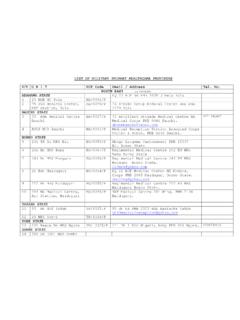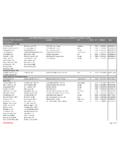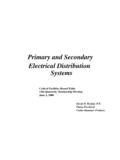Transcription of Uganda Post-primary Education Sector Report - World Bank
1 Africa Region Human DevelopmentWorking Paper SeriesUganda Post-primary EducationSector ReportAfrica RegionThe World BankXiaoyan Liang September 2002 Human Development SectorAfrica RegionThe World BankThe views expressed within are those of the authors anddo not necessarily reflect the opinions of the WorldBank or any of its affiliated the mid 1980s, Uganda has become oneof Africa s success stories. Reform measuresintroduced by the current government havebeen largely implemented, and the country is on aroad toward steady economic is particularly prominent in the educa-tion Sector , and especially in primary Education .
2 Thepresident s decision in 1996 to eliminate primaryschool fees for up to four children per family re-moved what had been an important economic im-pediment for families to enroll and maintain theirchildren at school. This decision also sent a strongsignal that basic Education is a high priority. By 2001,the gross enrollment ratio for primary educationstood at more than 120 Education , on the other hand, has re-ceived less attention. This is particularly the casefor the different types of secondary Education , whichis the focus of this Report . At about 19 percent in2000, the gross enrollment ratio for the full six-gradecycle of general secondary Education is well belowthe Sub-Saharan average of almost 30 percent.
3 Inaddition to low coverage, access rates differ consid-erably by gender, parental income, and area of resi-dence. Moreover, internal efficiency and studentachievement is low. The quality and coverage ofvocational and technical Education and training is alsolow, comparatively costly, and ill adapted to labormarket Uganda is right in giving top priority toachieving universal primary Education , secondaryeducation now requires urgent attention as recent rapid enrollment growth in primary edu-cation is causing a sharp increase in the demand foreducation beyond the primary level. Furthermore,there is a wide international consensus on the criti-cal role played by good quality secondary educa-tion in enabling countries to train the manpowerrequired to benefit from the ICT and knowledgerevolution, and to compete successfully in the newglobalized, knowledge-based economy.
4 Secondaryeducation also yields considerable private returns,and provides opportunities to acquire attitudes,skills, and competencies that enhance the ability ofyoung people to participate fully in society, takecontrol of their lives, and continue learning at thepost-secondary , similar to other Sub-Saharan Africancountries, Uganda faces enormous challenges inmaintaining the drive towards good quality univer-sal primary Education while, at the same time, re-sponding to the increasing social and economic de-mand for rapid expansion of secondary educationas well. In considering their options for expandingaccess to secondary Education , governments haveto decide on difficult trade-offs between the role ofpublic financing in supporting different levels(lower and upper secondary Education ), and typesof secondary Education (general, technical, voca-tional), as well as in ensuring equity in provisionbetween different population groups ( , boys andgirls, urban/rural, poor and more well-off groups).
5 IvAFRICA REGION HUMAN DEVELOPMENT WORKING PAPER SERIESThis Report was prepared by Xiaoyan Liang, task team leader, under the supervision of Paud Murphy,lead Education specialist, AFTH1, and Dzingai B. Mutubmuka, Sector manager, AFTH1. Teams mem-bers Harriet Nannyonjo and Debbie Peterson, AFTH1, provided support, and background paperswere supplied by Paul Bennell, Charles Byaruhanga, Jack Keating,Victor Levine, Keith Lewin,TonyRead, the Uganda National Education Bureau, International Development Consultants Ltd., andImpact Associates in association with Monarch Consulting Uganda , the author worked in collaboration with the Ministry of Education and Sports, Uganda ,the Department of Secondary Education , the Department of Business, Technical, and Vocational Edu-cation and Training.
6 Peer reviewers Jacob Bregman, David Court, Toby Linden, Peter Moock, andAdriaan M. Verspoor offered valuable comments and feedback. Additional written comments werereceived from Amit Dar, Bruce N. Jones, Soren Nellemann, and Michael Ward (DFID Uganda ).Final editing and formatting of the Report were done by Lawrence study is designed to help the governmentclarify these trade-offs. The study represents a com-prehensive review of Uganda s secondary educa-tion Sector . It is based on new data gathered specifi-cally to examine the cost, quality, and demand forsuch Education . The analysis also draws on a wealthof existing data and studies.
7 Findings from all pre-vious studies of Post-primary Education are synthe-sized to produce a comprehensive picture. For eachaspect of access, equity, quality, management andfinancing, the study discusses the achievements todate, the challenges ahead, and broad options study was developed in consultation withthe Ugandan Ministry of Education and Sports. Italso represents a collaborative effort between theWorld Bank and other development partners in theEducation Funding Agency Group in Uganda . TheNorwegian Education Trust Fund supported it fi-nancially. We hope the study will contribute to thenational consultative process that is currently un-derway and serve as a platform on which to build asustainable Post-primary Education Strategic Plan FredriksenSenior Education AdvisorAfrica Region.
8 The World BankContentsForeword .. Summary .. ix1. Introduction .. importance of Post-primary Education .. Purposes of the study .. Sector Report development process .. Data sources .. Definition of Post-primary Education .. Organization of the Sector Report .. 62. Demographic, Social and Economic Context .. 73. Education Sector Overview .. Structure of the Education system .. Size of the Education Sector .. Selected basic indicators of the Education system in Uganda .. Government expenditure on Education .. 114. Uganda Post-primary Education .. Policy, objectives, structure, admission, and size.
9 System performance .. System inputs .. Cost and financing of Post-primary Education and training .. Business, technical and vocational Education .. Private provision of Post-primary Education and training .. Cost effectiveness of various PPET institutions .. 605. PPET Enrollment and Transition Rates Projections .. 636. Conclusions .. 667. Policy Options .. 68A. Short-term focus on increasing efficiency of the current system: Expanding and improving qualityB. Medium-term focus on more equitable distribution of public financing to improve coverage,equity, and quality of PPET (within 5 10 years).
10 69C. Long-term focus on structure, curriculum, and teacher reform to improve the quality and relevanceof PPET Education .. 71 References ..74viAFRICA REGION HUMAN DEVELOPMENT WORKING PAPER SERIESA nnex of Secondary Enrollment Using Multiple Regression Method .. 75 Annex 2. Analyzing Private Direct and Opportunity Costs of PPET ..77 Annex 3. Projected Cost of Adopting Short-term Efficiency Measures ..83 TablesTable 1 World Bank lending to Uganda .. 5 Table 2 Poverty and social indicators .. 9 Table 3 Population projections from 2000 (estimated) to 2025, Uganda ..9 Table 4 Schools, enrollments, and teachers by type.


















